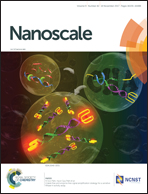Solution-processed indium oxide electron transporting layers for high-performance and photo-stable perovskite and organic solar cells†
Abstract
Interface engineering is considered the key to improving the device performance and stability of solar cells. In particular, TiO2 nanostructures, when used as electron transporting layers (ETLs) in metal halide perovskite solar cells (PSCs), led to excellent power conversion efficiencies (PCEs) of over 20%. They effectively transferred charge carriers from the perovskite and suppressed charge recombination at the interfaces. However, the photocatalytic effect of TiO2 on the perovskite can significantly degrade the device performance under ultraviolet illumination. Therefore, other classes of n-type metal oxides with a wide band gap should be developed to improve their photo-stability. Herein, we demonstrate the development of In2O3 thin films by a solution process and their application as ETLs in PSCs and organic solar cells (OSCs). Pin hole-free In2O3 ETLs obtained by the thermal decomposition of an In precursor thin film exhibit high conductivity (2.49 × 10−4 S cm−1) and low surface roughness (7.33 nm). This leads to impressive PCEs of 14.63% and 3.03% for the PSC and the inverted OSC, respectively. Furthermore, the In2O3-PSC shows better photo-stability than the TiO2-PSC by virtue of the wider band gap of In2O3, which leads to a PCE retention of 74% and 46%, relative to the initial PCE values of the PSC and the inverted OSC, respectively.



 Please wait while we load your content...
Please wait while we load your content...